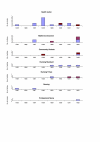Informal knowledge transfer in the period before formal health education programmes: case studies of mass media coverage of HIV and SIDS in England and Wales
- PMID: 17941972
- PMCID: PMC2194775
- DOI: 10.1186/1471-2458-7-293
Informal knowledge transfer in the period before formal health education programmes: case studies of mass media coverage of HIV and SIDS in England and Wales
Abstract
Background: How advances in knowledge lead via behaviour change to better health is not well understood. Here we report two case studies: a rapid reduction in HIV transmission in homosexual men and a decline in Sudden Infant Death Syndrome (SIDS) that took place in the period before the relevant national education programmes commenced, respectively, in 1986 and 1991. The role of newspapers in transferring knowledge relevant to reducing the risk of AIDS and SIDS is assessed.
Methods: HIV Searches were made of The Times (1981-1985), Gay News (1981-1984) and, for the key period of April to June 1983, of eight newspapers with the highest readership. Information on transmission route and educational messages were abstracted and analysed. SIDS Searches were made of The Times and the Guardian (1985-1991), The Sun (selected periods only, 1988-1991) and selected nursing journals published in England and Wales. Information on sleeping position and educational messages were abstracted and analysed.
Results: HIV Forty-five out of 50 articles identified in newspapers described homosexuals as an at risk group. Sexual transmission of AIDS was, however, covered poorly, with only 7 (14%) articles referring explicitly to sexual transmission. Only seven articles (14%) associated risk with promiscuity. None of the articles were specific about changes in behaviour that could be expected to reduce risk. Gay periodicals did not include specific advice on reducing the number of partners until early 1984. SIDS Out of 165 relevant articles in The Times and 84 in the Guardian, 7 were published before 1991 and associated risk with sleeping position. The reviewed nursing journals reflected a pervasive sense of uncertainty about the link between SIDS and sleeping position.
Conclusion: Presumptively receptive audiences responded rapidly to new knowledge on how changes in personal behaviour might reduce risk, even though the 'signals' were not strong and were transmitted, at least partly, through informal and 'horizontal' channels. Advances in knowledge with the potential to prevent disease by behaviour change may thus yield substantial health benefits even without the mediation of formal education campaigns ('interventions'). Formal campaigns, when they came, did make important additional contributions, especially in the case of SIDS.
Figures



Similar articles
-
Population mixing and sudden infant death syndrome in England and Wales.Int J Epidemiol. 1994 Jun;23(3):540-4. doi: 10.1093/ije/23.3.540. Int J Epidemiol. 1994. PMID: 7960379
-
[SIDS prevention program in Tyrol].Wien Klin Wochenschr. 2000 Mar 10;112(5):209-15. Wien Klin Wochenschr. 2000. PMID: 10763533 German.
-
Changing conclusions on secondhand smoke in a sudden infant death syndrome review funded by the tobacco industry.Pediatrics. 2005 Mar;115(3):e356-66. doi: 10.1542/peds.2004-1922. Pediatrics. 2005. PMID: 15741361
-
[4th Austrian SIDS Consensus-Consultation and the Viennese SIDS prevention campaign "Secure Sleep"].Wien Klin Wochenschr. 2000 Mar 10;112(5):187-92. Wien Klin Wochenschr. 2000. PMID: 10763529 Review. German.
-
Reducing the risk of sudden infant death syndrome: a review of the scientific literature.J Paediatr Child Health. 1998 Jun;34(3):213-9. doi: 10.1046/j.1440-1754.1998.00225.x. J Paediatr Child Health. 1998. PMID: 9633965 Review.
Cited by
-
A decline in the prevalence of injecting drug users in Estonia, 2005-2009.Int J Drug Policy. 2013 Jul;24(4):312-8. doi: 10.1016/j.drugpo.2012.11.002. Epub 2013 Jan 3. Int J Drug Policy. 2013. PMID: 23290632 Free PMC article.
-
Innoversity in knowledge-for-action and adaptation to climate change: the first steps of an 'evidence-based climatic health' transfrontier training program.Adv Med Educ Pract. 2010 Dec 21;1:89-105. doi: 10.2147/AMEP.S14027. Print 2010. Adv Med Educ Pract. 2010. PMID: 23745068 Free PMC article.
-
"It doesn't exist, only other people have it, or it's bad luck": perceptions of HIV as barriers to its prevention in Bata.BMC Public Health. 2023 Nov 27;23(1):2347. doi: 10.1186/s12889-023-17215-0. BMC Public Health. 2023. PMID: 38012625 Free PMC article.
-
Integrating the Demographic and Health Surveys, IPUMS-I, and TerraPopulus to Explore Mortality and Health Outcomes at the District Level in Ghana, Malawi, and Tanzania.Etude Popul Afr. 2014 Jul;28(2 Suppl):917-926. doi: 10.11564/28-0-545. Etude Popul Afr. 2014. PMID: 27330245 Free PMC article.
References
-
- McKee M, Fulop N, Bouvier P, Hort A, Brand H, Rasmussen F, et al. Preventing sudden infant deaths – the slow diffusion of an idea. Health Policy. 1996;37:117–135. - PubMed
-
- Nicoll A, Hughes G, Donnelly M, Livingstone S, De AD, Fenton K, et al. Assessing the impact of national anti-HIV sexual health campaigns: trends in the transmission of HIV and other sexually transmitted infections in England. Sex Transm Infect. 2001;77:242–247. doi: 10.1136/sti.77.4.242. - DOI - PMC - PubMed
MeSH terms
LinkOut - more resources
Full Text Sources
Medical
Miscellaneous

